
Volume: 11 Issue: 08 | Aug 2024 www.irjet.net p-ISSN:2395-0072


Volume: 11 Issue: 08 | Aug 2024 www.irjet.net p-ISSN:2395-0072
Jaba Blessy W.U1 , I.Siva Prasad Manivannan., M.E., M.B.A., 2
1PG Student, Dept. of Computer Science Engineering, Rohini College of Engineering and Technology, Kanniyakumari Tamil Nadu, India
2Professor, Dept. of Computer Science Engineering, Rohini College of Engineering and Technology, Kanniyakumari, Tamil Nadu, India.
Abstract In the era of cloud computing, consumers like users, businesses, and organizations prefer to subcontract massive geographical data to public clouds after encryption for privacy and security in order to achieveconvenientlocation-basedservice(LBS).Bethatas it may, various hurtful digital assaults occur on those public mists in an unpredicted and hourly way. In existing framework propose a lightweight and forward-secure reach question (LS-RQ) on geologically encoded information, which sufficiently balances among security and productivity. It was costly and can be satisfactory by and by since the exact outcome just included a couple of focuses ordinarily. In this task propose the meaning of the forward protection for secure reach look. Likewise, show how three broadly utilized cryptographic devices request safeguarding encryption (OPE), pseudorandom capability, and once cushion can be utilized to plan a proficient, precise, and forward secure (EAFS) accessible encryption conspire supporting reach search in encoded mathematical data sets. In the proposed EAFS conspire, a hidden entrance just matches the last information record that fulfills the pursuit range, and different outcomes are found iteratively utilizing the past outcome. OPE's efficiency, forward privacy, and accuracy are simultaneously guaranteed by its chain-like search and embeddedciphertexts.
KeyWords:CipherText,LocationBasedService (LBS), Cyber-attacks, Order preserving encryption.
For a variety of reasons, including the ability to access our data from any location at any time with any computingdevice,higherservicequality,andlowercosts associated with data management, cloud servers (CSs) are increasingly being used to store data. Data on our laptops and mobile devices may be automatically transferred to CSs like iCloud or OneDrive in some
instances. There are known security and protection issues related with the reevaluating of information, for example, thecloudspecialistco-op(CSP)gainingadmittancetoclient contents without their unequivocal authorization. This supports the significance of accessible encryption (SE), a cryptography based plot that empowers looking in the ciphertext space without releasing any data to untrusted servers. There are a wide range of SE plans, with shifting functionalities(e.g.,watchwordsearchesandlikenesslook). Range look are one more typical capability in data sets that spotlights on numeric correlations, for instance to find clientssomewhereintherangeof20and40yearsofage.
Thedatamaybeprocessedtofitaparticulardatastructure, such as a B-tree, in which the data are stored in order, to improve range search efficiency. This is not difficult to accomplishintheplaintextspace,howevernotthesituation when data sets are encoded. First, there is insufficient semanticinformationintheencryptedenvironmenttoallow for numerical comparisons. In addition, in order to verify equality, it is impractical to list all possible cases for the entire range in a search request. Second, the request between various information records is likewise touchy data.Allinall,theinformationproprietor(DO)forthemost part doesn't believe the CS should be familiar with the request between various information records, and the list shouldn't uncover the request data preceding looking. As a result,rangesearchingintheciphertextdomainisdifficult.
Bijit Hore et al. [1] proposed Secure multi-faceted reach questions over reevaluated information. Questions are assessed in a rough way where the returned set of records might contain a few misleading up-sides. These records then, at that point, should be gotten rid of by the client which contains the computational above of our plan. We fostera bucketizationsystemfornotingmulti-facetedreach questions on complex information. We estimate the client's computational overhead and disclosure risk for a given bucketizationschemeusingcostanddisclosureriskmetrics. Shabnam Kasra Kermanshahi et al. [2] proposed International Research Journal of Engineering and Technology (IRJET) e-ISSN:2395-0056

International Research Journal of Engineering and Technology (IRJET) e-ISSN:2395-0056
Volume: 11 Issue: 08 | Aug 2024 www.irjet.net
Mathematical Reach Search on Scrambled Information. This article presents two powerful symmetric accessible encryption plans for mathematical reach search. Our developments are quick to give forward/in reverse security with regards to SSE-based plans supporting mathematical reach search. Plus, we characterize a securitythoughtcalledcontentprotection.Leaksthatare crucial in the context of geometric range search but are nottakenintoaccountbyforward/backwardsecurityare capturedinthissecurityconcept.Duringbothsearchand update, content privacy eliminates leakage of updated databasepoints.
Cong Zuo et al. [3] proposed Forward and In reverse Confidential DSSE for Reach Questions. In this article, they first give another spillage capability for range questions,whichismoremuddledthantheoneforsingle catchphrasequestions.Besides,weproposeasubstantial forward and in reverse confidential DSSE conspire by utilizing a refined double tree information structure. Xiangyu Wang et al. [4] proposed Forward/In reverse and Content Confidential DSSE for Spatial Watchword Questions. Spatial catchphrase questions are appealing strategies that have been broadly. sent, all things considered, applications as of late, for example, interpersonal organizations and area based administrations. However, the solutions that are currently available neither meet the privacy requirementsofactualapplicationsnorsupportdynamic update. In this article, they explore the issue of Dynamic Accessible Symmetric Encryption (DSSE) for spatial catchphrase questions. Kaiping Xue et al. [5] proposed Secure two-cloud database for numerically related SQL rangequeries.Businessesandpeoplereevaluatedataset to acknowledge advantageous and minimal expense applications and administrations. Numerous secure database strategies have been proposed in order to provide SQL queries with sufficient functionality. Notwithstanding, such plans are defenseless against security spillage to cloud server. Ke Cheng et al. [6] designed Emphatically Secure and Effective Reach Questions in Cloud Data sets under Various Keys. proposeasafeclouddatasetsupportingreachquestions undervariouskeys,inwhichall clientscouldprotectthe privacy of their own different keys, and don't need to impartthemtooneanother.Atamoreelevatedlevel,our framework is developed on a two-cloud design and an original dispersed two-hidden entryway public key cryptosystem. Wai Kit Wong et al. [7] designed Data interoperability and secure query processing in a cloud database environment. propose and break down a safe inquiryhandlingframework (SDB)onsocialtablesanda bunch of rudimentary administrators on scrambled
p-ISSN:2395-0072
information that permit information interoperability, which permitsanextensivevarietyofSQLquestionstobehandled bytheSPonencodeddata.RezaCurtmolaetal.[8]proposed Accessible symmetric encryption. Accessible symmetric encryption (SSE) permits a party to re-appropriate the stockpilingofitsinformationtoanotherparty(aserver)ina confidentialway,whilekeepingupwiththecapacitytolook through ready to be done specifically. This issue has been the focal point of dynamic examination as of late. In this paper we show two answers for SSE that at the same time partake in the accompanying properties: In comparison to all previous constant-round schemes, both solutions are more effective. Specifically, the work performed by the serverperreturnedrecordisconsistentratherthandirectin the size of the information. Ioannis Demertzis et al. [9] proposed Deep and Practical Private Range Search In this article, they adopt an interdisciplinary strategy, which joins the meticulousness of safety details and confirmations with effective information the board methods. They develop a wide arrangement of novel plans with practical security/execution compromises, taking on the idea of Accessible Symmetric Encryption (SSE), principally proposed for watchword search. Rui Li et al. [10] proposed Range query processing that is quick and scalable. They propose the principal range inquiry handling plan that accomplisheslistvagaryunderthelackofdefinitionagainst picked watchwordassault(IND-CKA).Ourkeythought isto sort out ordering components in a total paired tree called PBtree,whichfulfillsstructurelackofdefinition.
In this article, present the proper definition for forward protection in range searches, and afterward propose a proficient, precise, and forward secure (EAFS) SE plot that fulfills this definition. To be explicit, our plan accomplishes secure reach search in a solitary CS model, and the precise outcomescanbegottenwithoutrepetitivecooperationsand postprocessing tasks. There are two parts to the search phase.Thefirststepistolocatethe datasetthatcompletely fulfills the search request, followed by the second step, which is to locate the dataset that only partially fulfills the search request and then compare the two datasets in order to return the correct results. As a result, the size of the aforementioned datasets has an impact on the level of difficulty of the search. Prior to a search, order and similarity information are hidden, and forward privacy is ensuredwhenthedatarecordsareupdated.

International Research Journal of Engineering and Technology (IRJET) e-ISSN:2395-0056
Volume: 11 Issue: 08 | Aug 2024 www.irjet.net
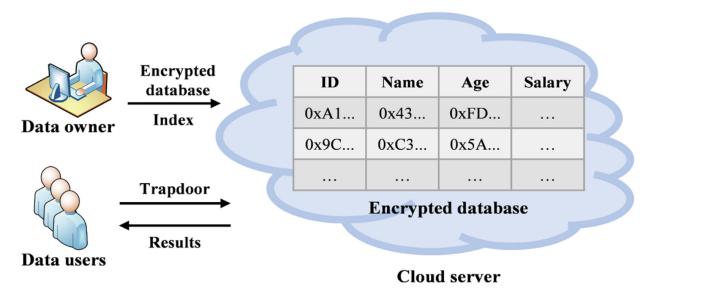
We are able to draw the conclusion that a straightforward cryptographic technology or tool cannot simultaneously guarantee the safety, effectiveness, and accuracy of range searches in encrypted databases. In thisway,weexpandontheonionsofencryption,whichis a multi-facet structure that stores numerous ciphertexts minimally. A secure range search's design can be guided by the security or functionality properties provided by each layer. Take note that the secure range search is impractical because its complexity is proportional to the size of the database that is, the total number of data records. An index that speeds up th range search should be created by processing the original data records (bucketing). What's more, a deterministic encryption (i.e., PRF) is expected to really take a look at the correspondenceandsafeguardthesecurityoftherecord. Itisinescapablethat a few bogus up-sideswill existas a tradeoff for expanding the effectiveness. To compare the ciphertexts, a functional encryption, such as OPE, is required. In any case, PRF and OPE are two more vulnerable encryption plans. The PRF uncovers which encoded values connect with the equivalent plaintext, which can be effortlessly undermined by the record infuse assault. The order of the initial data records is shown by the OPE. In this manner, a more grounded encryption (i.e., once cushion) is expected to ensure the security of the reach search. At long last, the chain-like pursuit executes the protected reach search where the intricacy just connects with the quantity of results fulfillingtheinquirysolicitationandafewbogusup-sides during the whole hunt process, as well as guaranteeing theforwardsecurity.
p-ISSN:2395-0072
To accomplishasafereachsearch,afewboundariesshould be created in the introduction stage. We expect that the information base Dmn is to be moved to CS. To begin with, DO produces a guide capability M to preprocess the information records in Dmn. Without loss of consensus, the guide capability is characterized by similarly partitioning the scope of each property into a decent number of (e.g., f) consistent sub-ranges, which produces fm cans. Then, to achieve the protected reach search, two records should be produced. As referenced over, the state file σ is instated as {〈B_1,0〉,〈B_2,0〉,… … ,〈B_(|B|),0〉}, and the encoded data set EDB is introduced as ∅. By contributing the security boundaryλDOproducestwomysterykeys,KPRFandKOPE, whichareutilizedtoassembletheencodeddatasetEDB.
To refresh information, the accompanying necessities should be met. To start with, the update for an information record just rolls out little improvements on the file, which guarantees the productivity of the update. Second, forward privacy is ensured by the fact that the newly updated data record has no connection to any of the previous entities in theencrypteddatabase.Third,thedelicatedataspilledfrom thelistislimitedtothedegreeconceivable.
ThestateindexwillberequiredasaninputifDUgeneratesa trapdoor because it contains counters representing the number of data records stored in each bucket, which is considered sensitive information about the database. The counters connected with the hunt range are required, yet the counters out of the pursuit range are uncovered. If DO producesa hidden entrance,he/she shouldrealize the hunt range, which likewise can be viewed as touchy data about DU. As a result, you should be able to meet the following requirements. To start with, DU just acquires the counters thathe/shewants,doesn'thoweveradvanceanythingabout different ones in the state record. Second, DO has no knowledgeoftheDUquery.
When carrying out the search procedure, it is necessary to satisfythefollowingrequirements.Tostartwith,thepursuit productivityconnectswiththesizeofresultsthatfulfillsthe hunt demand, which empowers our plan to be utilized in enormous scope data sets. Second, the accuracy and completeness of the secure range search's output guarantees the search's quality. Thirdly, DU has a great experience because there is no additional interaction

International Research Journal of Engineering and Technology (IRJET) e-ISSN:2395-0056
Volume: 11 Issue: 08 | Aug 2024 www.irjet.net
between CS and DU or any post-process
In this section, We look at how well our plan works. We used both an artificial dataset, i.e., a manmade uniform distribution dataset known as dataset 1, and an actual dataset, i.e., the diabetes dataset1 in the UCI Machine Learning Repository known as dataset 2, because the distributionofthedata hasa strongcorrelation withthe computational costof a securerangesearch. The Python programming language is used to write the code for our scheme's entire procedure. Our computer simulated DO and DU. We used the real CS of Microsoft Azure to store the encrypted database and carry out the secure range searchtoguaranteetheviabilityofourplan.
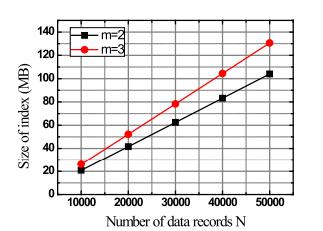
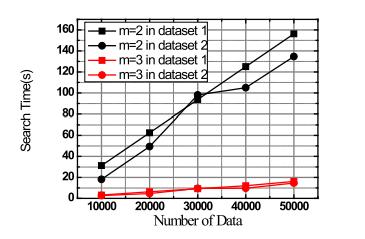
p-ISSN:2395-0072
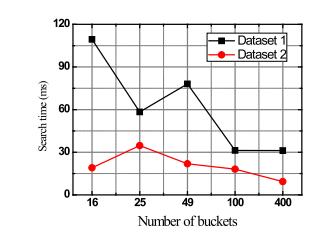
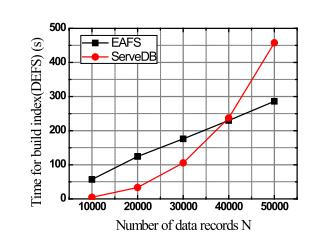
-3 (a) Computation cost for different number of buckets (b) Computation cost for building index
Fig. 2(a) shows the relationship between the size of the index (aka., EDB) and the number of data records. The recordputawayinCSisawordreferencewithakey-esteem pairthatisfiguredbythesolidhashcapabilities.Thelength of the word reference connects with the quantity of information records in the data set. As a result, as the number of data records increased, so did the size of the index.TherewouldbemoreciphertextsencryptedbyOPEas the dimensions increased. The size of the record expanded straightly as the quantity of aspects expanded. Fig. 2(b) depictstherelationshipbetweenthenumberofdatarecords and the amount of computation required for secure range search.TheEAFS'ssearchcomplexityisO(Q+F),whereQis the number of data that satisfy the query and F is the number of false positive data, as previously mentioned. Whenthenumberofattributesistakenintoaccount,weset thenumberof(Q+F)tobealmost2%ofthedataset'stotal number.Figs.3(a)and(b)showtheconnectionbetweenthe calculation cost of our plan and the absolute number of containers, |B|. Assuming the complete number of cans is little, and that implies that the scope of each pail is wide,

International Research Journal of Engineering and Technology (IRJET) e-ISSN:2395-0056
Volume: 11 Issue: 08 | Aug 2024 www.irjet.net p-ISSN:2395-0072
more bogus positive information records are looked for a similar inquiry token, in this way, hence, the hunt time will increment.
The proposed the definition of forward privacy in range search, as well as the creation of an EAFS SE scheme that makes it possible to perform secure range searches in encrypted databases. The computational expense for a reachsearchinourEAFSjustconnectswiththequantityof results that fulfill the question and the quantity of bogus up-sides in the converging containers. Forward privacy is achievedbecausethechain-likesearchguaranteesthatany newly updated data entities have no connection to the previous data. We additionally assessed the security and execution of our way to deal with exhibit the utility of the EAFS.
[1] Cong Zuo; Shi-Feng Sun; Joseph K. Liu et al. Forward and Backward Private DSSE for Range Queries, IEEE Transactions on Dependable and Secure Computing,2022
[2] Xiangyu Wang; Jianfeng Ma; Ximeng Liu. Forward/Backward and Content Private DSSE for Spatial Keyword Queries, IEEE Transactions on DependableandSecureComputing,91-48,2023
[3] K.Xue,S.Li,J.Hongetal.Two-cloudsecuredatabasefor numeric-related SQL range queries with privacy preserving, IEEE Transactions on Information Forensics andSecurity,2017.
[4] K. Cheng et al. Strongly secure and efficient range queries in cloud databases under multiple keys, IEEE INFOCOM 2019 - IEEE Conference on Computer Communications,2019.
[5] W. Wong, B. Kao, D. W. Cheung et al. Secure query processingwithdatainteroperabilityinaclouddatabase environment, Secure query processing with data interoperability in a cloud database environment, 2014, pp.1395–1406.
[6] R. Curtmola, J. Garay et al. Searchable symmetric encryption: Improved definitions and efficient constructions,ACMdigitallibrary,2006.
[7] I.Demertzisetal.Practicalprivaterangesearchindepth, ACMTransactionsonDatabaseSystemsVol.43,No.1.
[8] R. Li, A. Liu et al. Fast and scalable range query processing with strong privacy protection for cloud computing, IEEE/ACM Transactions on Networking Volume:24,Issue:4,August2016.
[9] B.Hore,S.Mehrotra,M.Canim,andM.Kantarciogluetal. Secure multidimensional range queries over outsourced data.TheVLDBJournal,2012.
[10] Shabnam Kasra Kermanshahi; Shi-Feng Sun et al. Geometric Range Search on Encrypted Data With Forward/Backward Security. IEEE Transactions on DependableandSecureComputing,Volume:19,2022.